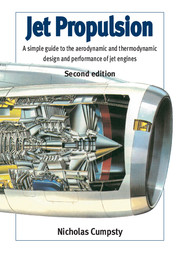 Jet Propulsion
Jet Propulsion Book contents
- Frontmatter
- Contents
- Preface
- Glossary
- Nomenclature
- Part 1 Design of Engines for a New 600-seat Aircraft
- 1 The New Large Aircraft – Requirements and Background
- 2 The Aerodynamics of the Aircraft
- 3 The Creation of Thrust in a Jet Engine
- 4 The Gas Turbine Cycle
- 5 The Principle and Layout of Jet Engines
- 6 Elementary Fluid Mechanics of Compressible Gases
- 7 Selection of Bypass Ratio
- 8 Dynamic Scaling and Dimensional Analysis
- 9 Turbomachinery: Compressors and Turbines
- 10 Overview of the Civil Engine Design
- Part 2 Engine Component Characteristics and Engine Matching
- Part 3 Design of Engines for a New Fighter Aircraft
- Part 4 Return to the Civil Transport Engine
- Appendix: Noise and its Regulation
- Bibliography
- References
- Index
- Design sheets for New Large Civil Aircraft and New Fighter Aircraft
10 - Overview of the Civil Engine Design
from Part 1 - Design of Engines for a New 600-seat Aircraft
- Frontmatter
- Contents
- Preface
- Glossary
- Nomenclature
- Part 1 Design of Engines for a New 600-seat Aircraft
- 1 The New Large Aircraft – Requirements and Background
- 2 The Aerodynamics of the Aircraft
- 3 The Creation of Thrust in a Jet Engine
- 4 The Gas Turbine Cycle
- 5 The Principle and Layout of Jet Engines
- 6 Elementary Fluid Mechanics of Compressible Gases
- 7 Selection of Bypass Ratio
- 8 Dynamic Scaling and Dimensional Analysis
- 9 Turbomachinery: Compressors and Turbines
- 10 Overview of the Civil Engine Design
- Part 2 Engine Component Characteristics and Engine Matching
- Part 3 Design of Engines for a New Fighter Aircraft
- Part 4 Return to the Civil Transport Engine
- Appendix: Noise and its Regulation
- Bibliography
- References
- Index
- Design sheets for New Large Civil Aircraft and New Fighter Aircraft
Summary
The emphasis of Part 1 of the book has been overwhelmingly towards the aerodynamic and thermodynamic aspects of a jet engine. These are important, but must not be allowed to obscure the obvious importance of a wide range of mechanical and materials related issues. In terms of time, cost and number of people mechanical aspects of design consume more than those which are aerodynamic or thermodynamic. Nevertheless this book is concerned with the aerodynamic and thermodynamic aspects and it is these which play a large part in determining what are the desired features and layout of the engine. Nevertheless an aerodynamic specification which called for rotational speed beyond what was possible, or temperatures beyond those that materials could cope with, would be of no practical use.
An aircraft engine simultaneously calls for high speeds and temperatures, light weight and phenomenal reliability; each of these factors is pulling in a different direction and compromises have to be made. Ultimately an operator of jet engines, or a passenger, cares less about the efficiency of an engine than that it should not fall apart. Engines are now operating for times in excess of 20000 hours between major overhauls (at which point they must be removed from the wing), and this may entail upward of 10000 take-off and landing cycles. In flight shut-downs are now rare and many pilots will not experience a compulsory shut-down during their whole careers.
- Type
- Chapter
- Information
- Jet PropulsionA Simple Guide to the Aerodynamic and Thermodynamic Design and Performance of Jet Engines, pp. 108 - 110Publisher: Cambridge University PressPrint publication year: 2003


